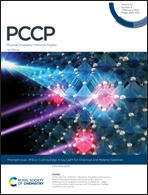A unified statistical RRKM approach to the fragmentation and autoneutralization of metastable molecular negative ions of hexaazatrinaphthylenes†
Abstract
For the compounds promising for use as n-type semiconductors in organic electronics and energy storage devices, hexaazatrinaphthylene (HATNA) and its derivative hexamethoxy-hexaazatrinaphthylene (HMHATA), the monomolecular processes occurring under the exposure of molecules to low-energy (0–15 eV) free electrons were studied by means of resonant electron capture negative ion mass spectrometry. Resonant electron attachment results in the formation of eminently long-lived molecular negative ions (MNIs) in an abnormally wide range of incident electron energy (Ee) from 0 to 5–7 eV. For both compounds, this observation serves as an indication of the strong electron-accepting properties and high stability of MNIs against electron autodetachment. A weak yield of the only fragment NIs, dehydrogenated anions, was detected for HATNA at Ee > 6 eV. MNIs of HMHATA are less stable to dissociative decay because of the presence of weakly bound terminal substituents. This is evidenced by the mass spectral observation of intense fragmentation occurring above Ee ≈ 1 eV and leading to a loss of up to 3 methyl groups as the Ee increases. A series of metastable NI peaks observed in the mass spectra testify to the delayed and sequential nature of fragmentation. Based on the principles of statistical Rice–Ramsperger–Kassel–Marcus (RRKM) theory, the theoretical model of dissociative decay of NIs was developed and then adopted to quantify the rates of ground-state anion decay via electron autodetachment. The experimentally measured electron autodetachment lifetimes and fragmentation rates were best reproduced by the model at molecular adiabatic electron affinities preset to 2.15 eV for HATNA and 1.88 eV for HMHATA, in reasonable agreement with the quantum chemical DFT PBE/3ζ predictions.



 Please wait while we load your content...
Please wait while we load your content...